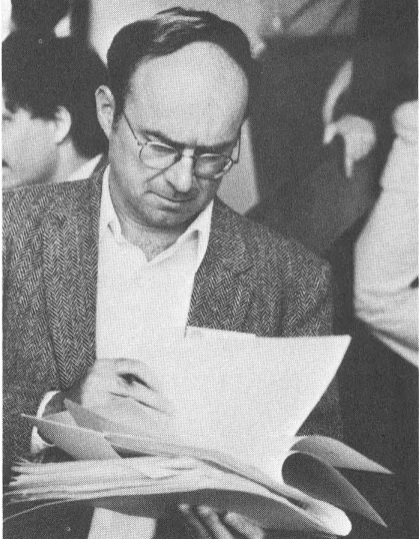Astrophysicists Host Spacey Conference
During the first week of May, the theoretical astrophysics group at Fermilab hosted an international conference on science at the interface of particle physics and cosmology/astrophysics. The conference "Inner Space/Outer Space" was attended by a very diverse group of more than 200 physical scientists, including astronomers, astrophysicists, cosmologists, low-temperature physicists, and elementary particle theorists and experimentalists. The common interest which brings this diverse group together is the connection between physics on the smallest scale probed by man--the realm of elementary particle physics--and physics on the largest scale imaginable (the entire Universe)--the realm of cosmology.
In its infancy the Universe was a hot soup of quarks and leptons, closely resembling the conditions created in very high energy particle collisions.
One of the intriguing connections between particle physics and cosmology is the possibility that most of the mass in the Universe resides in a yet-to-be-detected sea of elementary particles which are relics of the earliest moments of the Universe. Marc Davis (UC Berkeley) gave an observer's view of the large scale structure in the Universe, and Jay Gallagher (Kitt Peak National Observatory) presented the evidence that there are more to galaxies than meet the eye--that is, that most of the mass in a galaxy is not in the form of stars. If the mass is not in the form of stars, it probably exists in a dark spherical halo, which is possibly comprised of the exotic relics mentioned above. Simon White (Arizona) summarized the results of numerical simulations of the formation of structure (i.e., galaxies, clusters, etc.) in model Universes with different types of elementary particles as the 'dark matter.' Based upon comparison of the simulations and the observations which were discussed by Davis, the preliminary conclusion is that the dark matter is probably not massive neutrinos, but might be more exotic particles such as axions or one of the particles from the supersymmetric zoo. On the final day of the conference, J.D. Bjorken (Fermilab) discussed the prospects for actually producing, at present or future accelerators, some of the more exotic (i.e., not yet known to exist) particles which have been suggested as candidates for the dark matter.
In the 15th century, Copernicus suggested that the earth is not at the center of the solar system. Bruno in the 16th century took the Copernican idea one step further when he wrote that there are innumerable suns, and an infinite number of earths revolve around those suns... In the 20th century, we discovered that our solar system is not at the center of our own galaxy, and that our galaxy is but one of billions of galaxies in the Universe. At the Fermilab conference we heard about equally heretical theories in which the Universe we observed might well be only one among many, that there may be more than three spatial dimensions, and that the matter of which we are made (neutrons, protons, electrons) may not be the dominant form of matter in the Universe. It is just possible that one of these ultimate extensions of the Copernican principle will be confirmed by high-energy experiments at Fermilab or elsewhere. We all hope that the physicists and astronomers working in this field fare better than did Bruno (who was burned at the stake, February 17, 1600).
In addition to the hectic scientific program (up to 12 hours of sessions a day!), the participants were treated to a cookout and a banquet and cocktail party at The University of Chicago. The entertainment at the banquet included James, "The Amazing" Randi, a professional magician, and Leon "The Laugh" Lederman, an amateur comedian.
The organizing committee for the Inner Space/Outer Space Conference included Rocky Kolb, David Lindley, Keith Olive, Chris Quigg, David Schramm, David Seckel, and Michael Turner.
The real work of organizing and running the conference was done by Marilyn Paul and Anne Burwell along with their very able staff of assistants Michelle Gleason, Teri Martin, Pat Oleck, Raeburn Wheeler, Sue Winchester, and Samuela Yarbrough.
Copies of transparencies from the talks are available for viewing in the library; designer t-shirts are available for $5 in the Astrophysics Department, WH3W.




